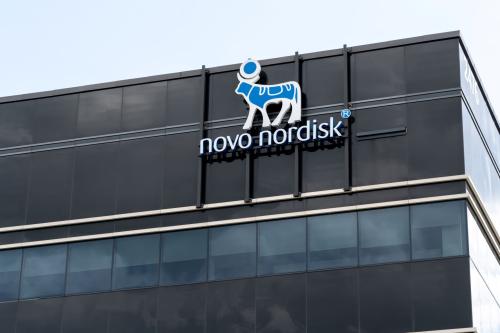This analysis is part of the USC-Brookings Schaeffer Initiative for Health Policy, which is a partnership between Economic Studies at Brookings and the University of Southern California Schaeffer Center for Health Policy & Economics. The Initiative aims to inform the national health care debate with rigorous, evidence-based analysis leading to practical recommendations using the collaborative strengths of USC and Brookings. The Commonwealth Fund has provided a grant to the Brookings Institution to support the work on which this post is based. Part 1 of this two-part blog originally appeared in Health Affairs on November 24, 2020. Part 2 was published in Health Affairs on November 25, 2020.
In Part 1 of this post, we provided background on U.S. drug prices and summarized an expert roundtable discussion held in June 2020 about the relationship between drug prices and innovation. The roundtable was convened by the USC-Brookings Schaeffer Initiative for Health Policy, with support from the Commonwealth Fund, and included current and former pharmaceutical and biotech executives, physician/scientist entrepreneurs, private equity and venture capitalists, and economists. Because the session was off the record to encourage people to speak freely, we convey the meeting’s general content without attributing specific comments or identifying the participants. Here, in part 2, we summarize the second half of the experts’ discussion, highlighting areas of general consensus among the roundtable participants.
What Is The Right Amount Of Innovation For Society?
While roundtable participants generally agreed that current U.S. drug pricing practices tend to encourage incremental rather than transformational innovation, a larger question surfaced during the discussion about what amount of innovation is actually best for society. The discussion centered on whether additional spending on priorities other than drugs would benefit society more or be preferred by the public:
“It seems to me [that] with widening income inequality, with a huge recession with lots of people without access to health care in the first place—like basic things that we know improve their lives—do they really want to be paying taxes/high prices to get innovation for things that that they can’t afford to begin with, and that if the government affords for them, it means they don’t have schools or vacations or roads or nursing homes?”
Although the view expressed by this participant was not widely shared, the question prompted a spirited discussion and helped crystallize a consensus regarding the importance of continuing to reward transformative innovation with high ROI, especially in the context of significant declines in average prices:
“If you come in with a me-too or me-three or me-four product, it [should] have a lower price than something really fantastic,” a participant said. “I think that if we could as a society credibly agree to pay for things that were really fantastic—like if tomorrow I had a cure for COVID, I should be able to charge a lot, and I, as a taxpayer, will be very happy with that compared to what we’ve got now, which is paying high prices for a lot of things that don’t do that much.”
There was also general agreement that the current U.S. market-based system does a poor job overall in fostering important innovation, and that high drug prices raise questions not only about affordability but also equity. The tension between equity and high prices means that “innovation will have to come side by side with some form of affordability.”
Lowering Drug Development Costs Could Maintain ROI with Lower Prices
Although specific reforms were not discussed, there was a consensus among participants about the importance of identifying ways to lower drug R&D costs without compromising safety and efficacy. Some discussed the potential to lower costs by modernizing some FDA requirements. For example, participants raised the prospect of relaxing requirements for large, randomized clinical trials and instead relying on registries or permitting post-market trials to focus on narrow subsets of patients rather than studying the entire population.
Lowering Drug Prices But Increasing Drug Companies’ Share Of Revenue Could Maintain ROI
Participants highlighted that a significant share of the revenue associated with purchasing drugs does not flow to manufacturers, leaving a large gap between gross revenues—the total paid when purchasing drugs—and net revenues retained by manufacturers. As one participant said, “We haven’t talked a lot about where the reimbursement dollar goes…. It doesn’t all go back to PhRMA—there’s a big middleman process in the U.S. that takes a big segment of this with rebates.”
An estimate of the potential savings from reducing the dollars diverted to middlemen wasn’t available during the discussion. Importantly, the effects of reforms intended to reduce marketing costs would differ from those related to eliminating—or reducing—rebates. Lower marketing costs could directly benefit manufacturers by decreasing their spending. One participant advanced a stark assessment: spending on marketing and middlemen reflect attributes of the current market-based system and its reliance on competition, suggesting that eliminating these costs could occur only by switching to a system that relied explicitly on price setting by government or quasi-governmental entities.
“If you wanted to spend less on drugs, but you wanted the same amount of money to go to manufacturers, then one way to do that would be to have nationally negotiated prices….You would not require as much marketing and, in particular, you could almost get rid of the whole PBM function because you wouldn’t need tiers and rebates, and all that stuff because there would be one price. So, you could subtract out quite a bit of the dollar spend and leave more of it to go into innovation…. And we’re going to get price competition from another place, which is government negotiation.”
However, it’s unclear how significantly marketing expenses would be reduced in a system with regulated prices because manufacturers would still have incentives to invest in marketing to expand or maintain the quantity of their product sold. While selling more of a drug would benefit any manufacturer, the expected return on marketing expenses might be greater for drugs with therapeutic alternatives—in effect, spending intended to shift market share from competitors.
As discussed in the first post of this series, it’s also unclear how eliminating or using a portion of rebates to lower patients’ out-of-pocket costs would affect overall drug spending. However, eliminating or redirecting rebates would cut off a revenue source that insurers now use to offset other costs and keep premiums lower.
Given the expectation that the current political climate would result in reductions in drug prices, participants expressed interest in the possibility of regulated prices, with some speculating that even industry stakeholders might warm to the idea of administered pricing. These participants tied that potential interest to whether a shift to regulated prices would significantly increase the share of revenue flowing to brand manufacturers. The calculus might turn on an assessment of how manufacturer revenue net of rebates and marketing costs would compare under the current system (given expected pressures to reform drug prices) and under administered pricing (but receiving a larger share of lower prices).
Drug Pricing In The U.S. And Other Developed Countries
In the U.S., drugmakers “price what the market will bear,” as a participant observed, which results in U.S. drug prices substantially exceeding those in other developed countries. Rather than relying on market forces, government or quasi-governmental entities in other countries play a significant role in drug pricing by negotiating prices with manufacturers. An important factor in determining negotiated prices typically involves the effectiveness of new drugs relative to existing treatments, which increases the potential ROI for breakthrough drugs relative to drugs offering only incremental improvement. Countries like the United Kingdom and France use cost-effectiveness analysis to directly tie pricing to increased effectiveness of new drugs, relying on assessments by public institutions like the National Institute for Health and Care Excellence, known as NICE, in England.
Another key point raised by a number of participants was that creating a more predictable, stable market and reducing uncertainty for drug companies would permit lower prices while maintaining acceptable ROI, as one participant observed:
“The U.S. is a wild card. A lot of the other countries, they’ve got multi-year contracts. They’ve got tenders that are renewed on a certain basis, and [manufacturers] know that they’re going to allocate a certain amount of drug to that country and therefore they can count on it in terms of revenue.”
Another participant added: “It may be less than they make proportionally in the U.S., but it is something that fits into a business model.” Having more certainty for longer periods of time about sales volume was considered an important factor in meeting expectations about adequate ROI.
Japan was cited by several participants as a market where prices are controlled without dramatically harming innovation. Typically, new drugs in Japan achieve much faster market entry and higher penetration than in the U.S. Although drugmakers initially charge relatively high prices, the government reduces prices in a systematic and usually predictable way:
“When you talk to them, they say it’s really simple—you control costs by controlling price, not a problem, and the government does that.”
To Lower U.S. Drug Prices, Don’t Export U.S. Problems To Other Countries
Noting that the United States could learn from and potentially adapt practices from other countries, several participants stressed the importance of not exporting U.S. drug pricing problems to other countries. Both the “most favored nation” interim final rule issued by the Trump Administration on November 20, 2020 and H.R. 3 passed by the House in the 116th Congress would rely on other countries’ ability to negotiate lower drug prices rather than on the U.S. establishing its own process to evaluate and regulate drug prices. Following up on the President’s earlier executive order and applicable only to Part B drugs, the newly-published most favored nation rule would limit the permissible price for Medicare Part B drugs to the lowest price for which a drug is sold in another country. H.R. 3, which applies to broadly and not just to Medicare, would require the federal government to set prices for selected drugs (those with high prices or lacking competition) between the lowest price in six high-income countries and 120 percent of the average price across those countries. Relying on prices used by other countries would be a stopgap policy that is unlikely to be as effective over time as having the United States address high drug prices directly. As one participant said:
“I feel somewhat strongly about us not outsourcing our problems in our inability to control costs onto other countries . . . So, saying, oh, we’re just going to pay what Canada pays, you know what that’s going to do, it’s going to raise the price in Canada.”
Others, however, stressed that the U.S. shouldn’t pick up the tab for global innovation:
“There is such a big disparity in terms of how much drugs get priced in the U.S., relative to the rest of the world. And, again maybe I’m a little idealistic, but I think we all should be paying for new innovative therapies—everyone on the globe—maybe not at the same level, but not at the disproportionate level today between us and the rest of the world.”
Nonetheless, concern was widely expressed that attempts to link U.S. prices to lower prices in other nations would likely create unintended consequences and disrupt other countries established processes for pricing new drugs by evaluating their effectiveness.
Need to Develop Better Measures Of Value
While participants acknowledged the need to have some way to quantitatively measure the value of new therapies, they raised concerns with the current capabilities of cost-effectiveness analysis. “Almost everybody on this call has agreed that what we ought to do is not pay for really marginal products,” a participant observed. “At the same time, we say we don’t like cost-effectiveness analysis, and I don’t see how you decide what a marginal product is unless you have something like cost-effectiveness analysis to guide you.”
Starting with the concern noted previously about exporting high U.S. drug prices to other countries, several participants urged that the U.S consider establishing its own process to set appropriate prices based on assessing the value of new drugs, rather than adopting the prices other countries negotiated with manufacturers. Many other industrialized countries rely on formal health technology appraisals, typically based on cost-effectiveness analysis, to assess the value of new therapies. A U.S. non-profit, the Institute for Clinical and Economic Review (ICER), conducts some of these analyses but lacks formal authority or governmental support.
These countries generally link prices and reimbursement for new drugs to reference pricing for existing, therapeutically similar drugs, often relying on standards such as quality-adjusted life-years (QALYs) or incremental cost-effectiveness ratios (ICERs). A QALY measures disease burden in terms of both quantity and quality of life, while an ICER is the ratio between the difference in cost and difference in benefit of two or more medical interventions. QALYs often are used to quantify the benefit of an intervention when calculating an ICER, which then typically is expressed as the incremental cost per QALY.
“I wish there was something better than the QALY, because honestly, I went to [business school], and I still have a hard time calculating QALYs and trying to explain it to people,” a participant said. “So, I’m all for cost effectiveness and paying for that. I just wish there was maybe a better rubric than QALYs.”
Acknowledging that QALYs certainly are imperfect measures, another participant said, “If you’re trying to price drugs or understand cost-benefit analysis, there’s no good way to do it yet….Somebody’s got to fill in that gap of what is life worth and how do drugs impact that and what’s the economic benefit to people who are going to pay—big, big question unsolved.”
Alternatives To Sustaining The Unsustainable
Despite concerns that deep price cuts would harm innovation, participants also acknowledged the imperative to slow U.S. spending growth, not just for drugs but for health care overall, as the nation spent almost 18 percent of gross domestic product on health care in 2018. Spending on retail prescription drugs (at 11 percent of personal health care spending in 2018) is still a relatively small slice of overall U.S. health care spending, and multiple participants argued that squeezing drug prices in isolation will do little to solve the overall cost and quality problems in U.S. health care. “Nobody tells you about the lousy [U.S. health care] delivery. We’re down around the Dominican Republic in terms of outcomes…. It’s really disastrous in terms of cost,” a participant said.
Participants would not be surprised if the United States were to follow the lead of other countries by adopting price regulation tied to cost effectiveness of new drugs, with one participant saying, “I agree that some kind of fixed pricing is ultimately the way we’re probably going to have to end up.” Given this expectation, during the roundtable, multiple ideas surfaced about how policymakers might balance the tension between lowering drug prices and encouraging investment in important innovation, including:
- Exploring how to lower the costs of drug development and approval.
- Understanding more fully how lower drug prices could increase access and potentially increase sales volume.
- Taking actions to lessen the impact of lower prices on drugmakers’ revenues, paying particular attention to differentiating between average reductions and the prices for important therapeutic advances.
- Ending unintended extensions of market exclusivity gained by drugmakers manipulating patent protections.
- Reducing uncertainty about drug sales volume—for example, over a multi-year period—in exchange for lower prices.
- Structuring rules to facilitate reduced spending on marketing and on intermediation (PBMs) in an environment that relies on regulated prices.
- Establishing formal cost-effectiveness measures that encourage transformative rather than incremental innovation.
-
Acknowledgements and disclosures
We are grateful to Tamara Hayford for advising on the design of the roundtable and providing comments on a draft of this blog and for the assistance of Alwyn Cassil.







Commentary
Balancing lower U.S. prescription drug prices and innovation – Part 2
November 25, 2020